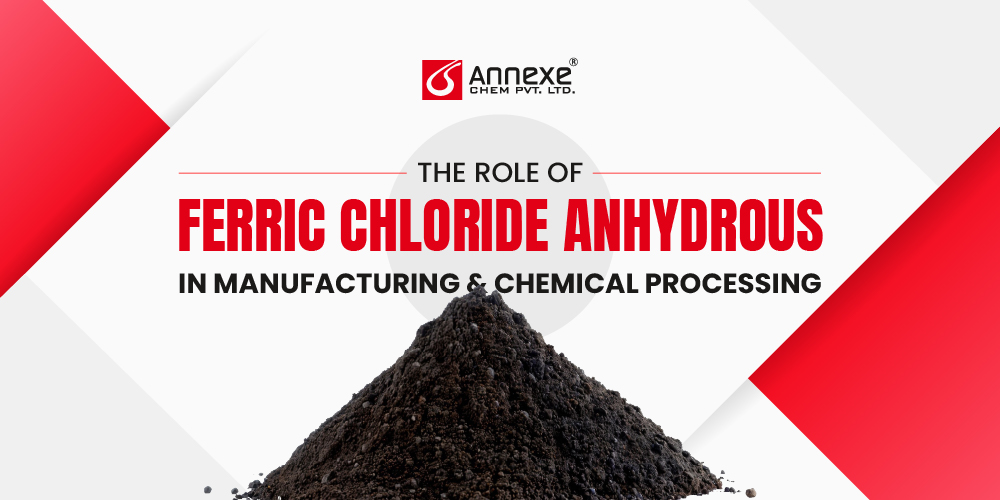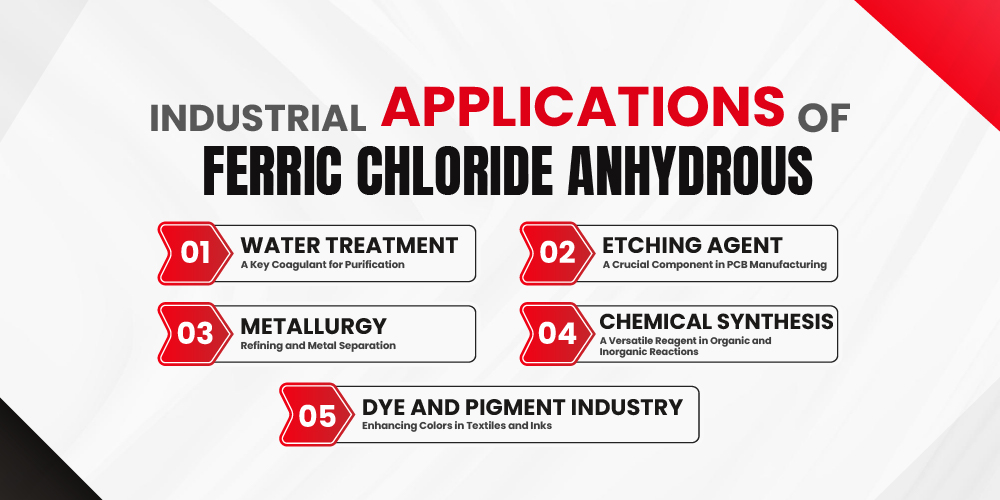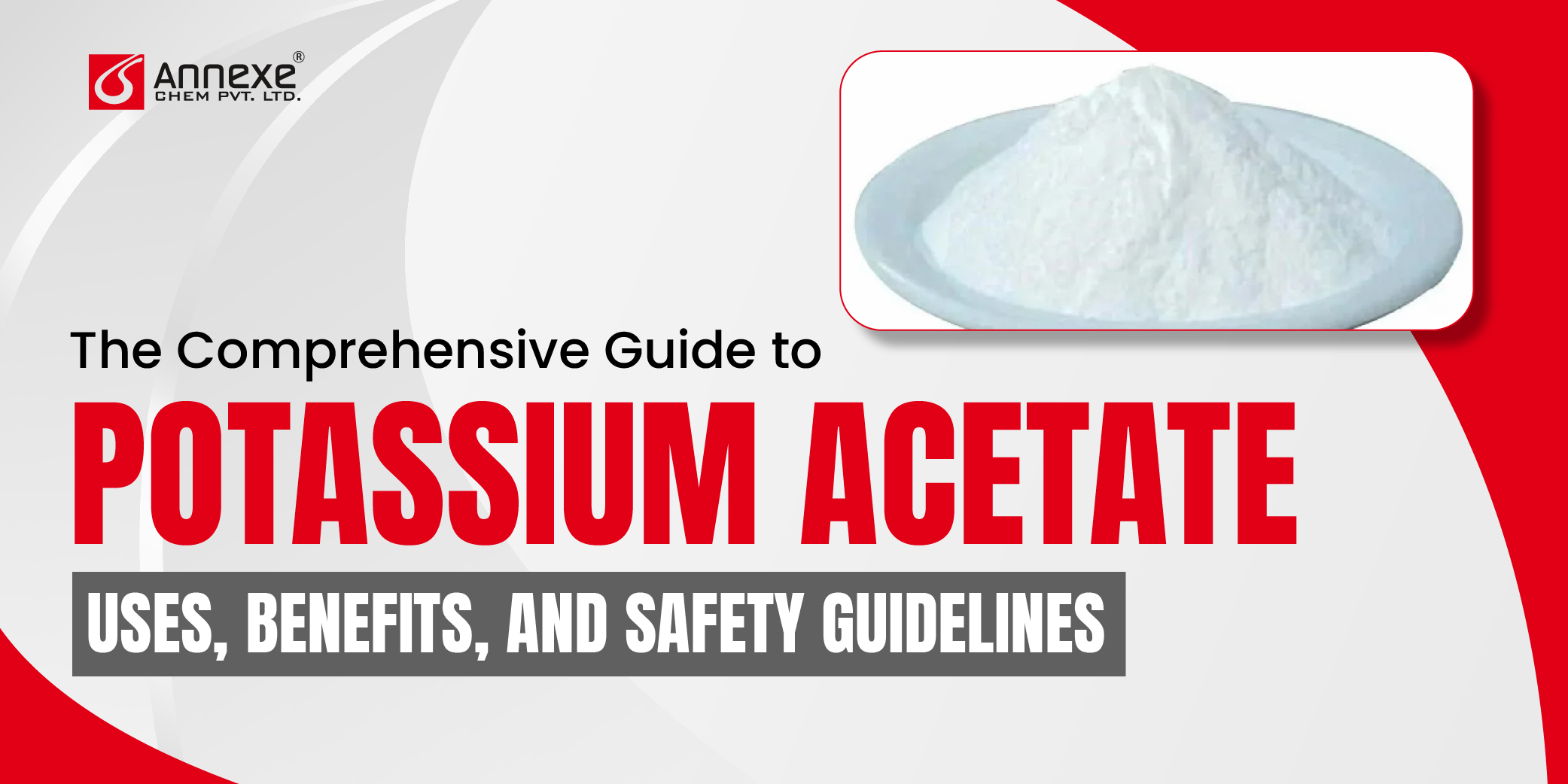Uses of Ferric Chloride Anhydrous in Industry
The Role of Ferric Chloride Anhydrous in Manufacturing & Chemical Processing

- February 22, 2025
- By Akshita Patel
Imagine a world without clean drinking water, advanced electronics, or high-quality metal refining. Sounds impossible, right? Well, Ferric Chloride Anhydrous is one of the unsung heroes making these essential processes possible.
Despite its intimidating chemical name, this compound plays a crucial role in industries ranging from water treatment to PCB manufacturing. Whether you’re an industry professional, a chemistry enthusiast, or just someone curious about how everyday processes work, this blog will dive into the fascinating world of Ferric Chloride Anhydrous—its properties, uses, and safety measures.
Let’s talk about the science behind this powerful chemical and see why it’s a game-changer in modern industry!
Ferric Chloride Anhydrous (FeCl₃) might not be a household name, but it plays a vital role in various industrial and chemical processes. This highly reactive, inorganic compound is widely used in water treatment, metal refining, and etching applications. Its strong corrosive nature and ability to react with water make it an essential chemical in many industries, but it also requires careful handling.
Chemical Properties & Composition Of Ferric Chloride Anhydrous
- Molecular Formula and Structure: Ferric Chloride Anhydrous has the chemical formula FeCl₃, consisting of one iron (Fe) atom and three chlorine (Cl) atoms. In its solid state, FeCl₃ forms a crystalline lattice structure, giving it unique physical and chemical properties. When dissolved in water, it undergoes hydrolysis, forming acidic solutions that are commonly used in industrial processes.
- Physical Appearance: In its anhydrous form, Ferric Chloride appears as dark brown or black crystalline lumps with a slight greenish hue. It is highly hygroscopic, meaning it readily absorbs moisture from the air, which can lead to the formation of its hydrated forms.
- Solubility and Reaction with Water: One of the most notable properties of FeCl₃ is its high solubility in water and organic solvents such as ethanol and acetone. However, when mixed with water, it reacts exothermically, generating heat and producing hydrochloric acid (HCl) as a byproduct. This acidic nature makes it useful in applications like wastewater treatment, where it acts as a coagulant to remove impurities.
- Oxidizing Properties: Ferric Chloride Anhydrous acts as a strong Lewis acid and oxidizing agent, meaning it can readily accept electrons in chemical reactions. This characteristic makes it useful in organic synthesis, etching metals, and removing contaminants in industrial settings. However, its strong oxidizing ability also makes it corrosive, requiring careful storage and handling.
By understanding these fundamental properties, it’s easy to see why Ferric Chloride Anhydrous is a go-to compound in various industrial applications. However, its reactivity also means that proper precautions are necessary when handling it, which we will explore further in the next sections.

Industrial Applications of Ferric Chloride Anhydrous
Ferric Chloride Anhydrous is a highly versatile compound with widespread applications across multiple industries. Its strong oxidizing properties, high solubility, and ability to react with various substances make it an essential chemical in water treatment, electronics, metallurgy, and beyond.
1. Water Treatment – A Key Coagulant for Purification
One of the most critical uses of Ferric Chloride Anhydrous is in wastewater and drinking water purification. It acts as a coagulant, helping to remove suspended particles, organic matter, and heavy metals from water.
How Does It Work?
When added to water, FeCl₃ hydrolyzes, forming ferric hydroxide (Fe(OH)₃), a gelatinous precipitate. This precipitate traps impurities and fine particles, making it easier to filter them out. The process also helps reduce phosphorus levels in water, preventing algal blooms in natural water bodies.
Why It’s Preferred?
- Works efficiently in a wide pH range compared to other coagulants.
- More effective at removing color, turbidity, and organic contaminants.
- Used in municipal and industrial wastewater treatment plants.
2. Etching Agent – A Crucial Component in PCB Manufacturing
Ferric Chloride is the go-to etchant for Printed Circuit Board (PCB) fabrication, making it indispensable in the electronics industry.
How Does It Work?
PCBs are coated with a copper layer, which needs to be selectively removed to create circuit pathways. FeCl₃ reacts with copper, dissolving unwanted portions while leaving protected areas intact. The result is a clean and precise circuit pattern, essential for smartphones, computers, and electronic devices.
Advantages in PCB Etching:
- Provides high-precision etching without affecting the remaining conductive material.
- Cost-effective and widely available compared to alternative etchants.
- Works efficiently at room temperature, reducing processing costs.
3. Metallurgy – Refining and Metal Separation
In the metallurgical industry, Ferric Chloride Anhydrous is widely used for refining and separating metals. Its ability to react with metals and convert them into soluble forms makes it useful in processes like:
- Metal Extraction – FeCl₃ helps extract and purify metals like copper, silver, and gold from ores.
- Pickling Process – It removes rust, scale, and oxide layers from iron and steel surfaces before further processing.
- Metal Recycling – Used in dissolving waste metal residues, making it easier to reclaim valuable elements.
Why It’s Beneficial?
- Selectively reacts with certain metals, allowing for precise separation.
- Enhances the quality of metals by removing impurities and oxides.
4. Chemical Synthesis – A Versatile Reagent in Organic and Inorganic Reactions
Ferric Chloride is widely used as an intermediate in various chemical reactions, playing a crucial role in organic and inorganic synthesis.
Applications in Chemical Synthesis:
- Catalyst in Organic Reactions – FeCl₃ is a strong Lewis acid, making it useful in Friedel-Crafts reactions, which are essential for producing pharmaceuticals, fragrances, and dyes.
- Oxidizing Agent – It facilitates oxidation reactions in industrial chemical production.
- Precursor for Other Ferric Compounds – FeCl₃ is used to produce ferric sulfate, ferric nitrate, and other iron-based chemicals.
Why It’s Used?
- Enhances reaction efficiency and yield in complex chemical processes.
- Provides a cost-effective and readily available alternative to other catalysts.
5. Dye and Pigment Industry – Enhancing Colors in Textiles and Inks
Ferric Chloride Anhydrous is also employed in the dye and pigment industry, where it plays a role in color development and fixation.
How It Contributes?
- Mordant in Textile Dyeing – FeCl₃ helps dyes bind more effectively to fabrics, improving color intensity and durability.
- Pigment Production – It is used in the synthesis of iron-based pigments, such as iron oxide reds and yellows, commonly found in paints and coatings.
- Ink Manufacturing – FeCl₃ assists in producing deep, rich black inks used in printing and calligraphy.
Benefits in the Dye and Pigment Industry:
- Improves color fastness, ensuring dyes don’t fade quickly.
- Provides an eco-friendly alternative to natural dye processes.
From water purification to high-tech electronics, metallurgy, chemical synthesis, and dyeing, Ferric Chloride Anhydrous proves to be an indispensable industrial chemical. Its versatility and strong reactivity make it a valuable tool across multiple sectors.
Safety and Handling Precautions for Ferric Chloride Anhydrous
Ferric Chloride Anhydrous is a highly corrosive and reactive chemical, requiring careful handling to prevent harm to personnel and the environment. Below are key safety measures to consider when working with this compound.
Corrosive Nature and Potential Hazards
- FeCl₃ is highly corrosive to metals and tissues, causing severe burns upon contact with skin or eyes.
- It reacts exothermically with water, releasing hydrochloric acid (HCl) fumes, which can irritate the respiratory system.
- Inhalation of its dust or vapors may cause throat irritation, coughing, and difficulty breathing.
Proper Storage and Handling Guidelines
- Store in airtight, corrosion-resistant containers to prevent moisture absorption and unwanted reactions.
- Keep in a cool, dry, and well-ventilated area, away from water, bases, and oxidizable materials.
- Use spill trays and secondary containment to prevent accidental leaks or spills.
Personal Protective Equipment (PPE) Recommendations
To minimize exposure risks, always wear:
- Chemical-resistant gloves (nitrile or neoprene)
- Safety goggles or face shield for eye protection
- Lab coat or protective clothing to prevent skin contact
- Respiratory mask (if working in poorly ventilated areas) to avoid inhalation hazards
First-Aid Measures in Case of Exposure
- Skin Contact – Rinse immediately with plenty of water for at least 15 minutes and remove contaminated clothing.
- Eye Contact – Flush eyes thoroughly with water and seek medical attention immediately.
- Inhalation – Move to fresh air and seek medical help if breathing difficulties persist.
- Ingestion – Do not induce vomiting; rinse mouth with water and seek immediate medical assistance.
By following these safety precautions, workers can minimize risks and ensure safe handling of Ferric Chloride Anhydrous in industrial settings.
Ferric Chloride Anhydrous is a powerhouse chemical with diverse applications, from water treatment and PCB manufacturing to metallurgy and dye production. Its strong reactivity, coagulant properties, and oxidizing nature make it indispensable across various industries. However, its corrosive nature and handling risks require strict safety precautions to ensure safe storage and usage. When looking for best Ferric Chloride Anhydrous manufacturer, choosing a reliable and high-quality supplier is essential—and that’s where Annexe Chem Pvt. Ltd. comes in.
Why Choose Annexe Chem Pvt. Ltd.?
At Annexe Chem Pvt. Ltd., we pride ourselves on being a trusted manufacturer and supplier of high-purity Ferric Chloride Anhydrous. Here’s why we stand out:
- Superior Quality Assurance – We follow strict quality control measures to deliver high-purity, industrial-grade FeCl₃.
- Customized Solutions – Our team provides tailored formulations to meet the specific needs of your industry.
- Reliable Supply Chain – With efficient production and prompt delivery, we ensure that your operations never face downtime.
- Commitment to Safety & Compliance – We adhere to international safety and environmental standards, guaranteeing responsible manufacturing and distribution.
Whether you’re in the water treatment, electronics, or chemical industry, Annexe Chem Pvt. Ltd. is your go-to partner for premium Ferric Chloride Anhydrous. Contact us today to discuss your requirements and get the best-in-class chemical solutions for your business!

Akshita Patel
As an advocate for sustainability, Akshita is committed to driving positive change within the chemical industry. She actively seeks out environmentally friendly solutions and promotes the adoption of sustainable practices. Akshita believes that a balance between economic growth and ecological responsibility is crucial for the industry's long-term success. She is dedicated to finding innovative ways to minimize environmental impact while maximizing efficiency and profitability.
Related Blogs

- May 5, 2025
- By Akshita Patel
What Is Calcium Sulphate Dihydrate? Key.
Ever wondered what holds your walls together, helps doctors make casts, and even shapes stunning sculptures?.

- August 13, 2024
- By Akshita Patel
The Comprehensive Guide to Potassium Acetate:.
When you think of potassium, you might picture bananas or sports drinks, but this versatile element.



